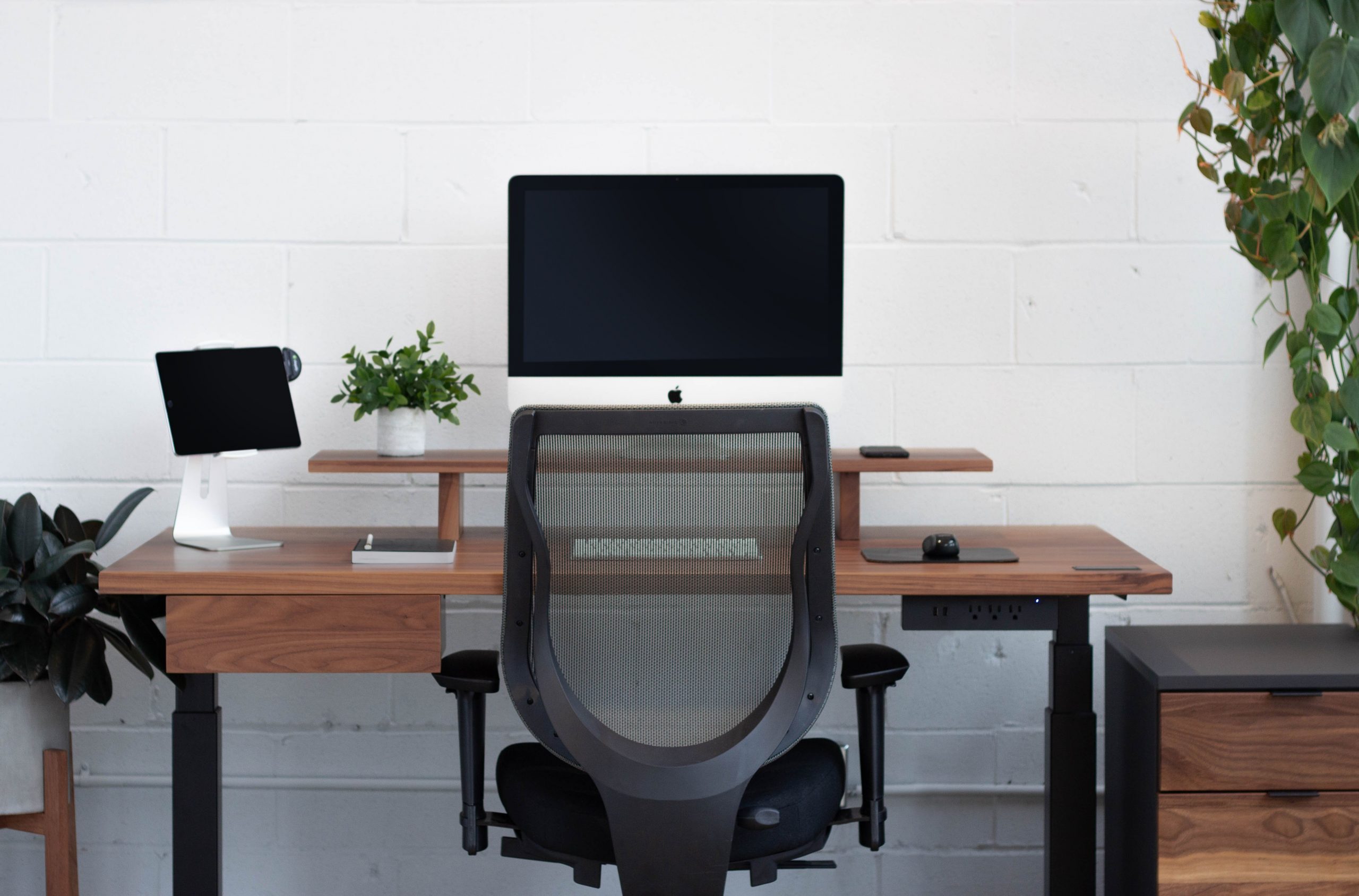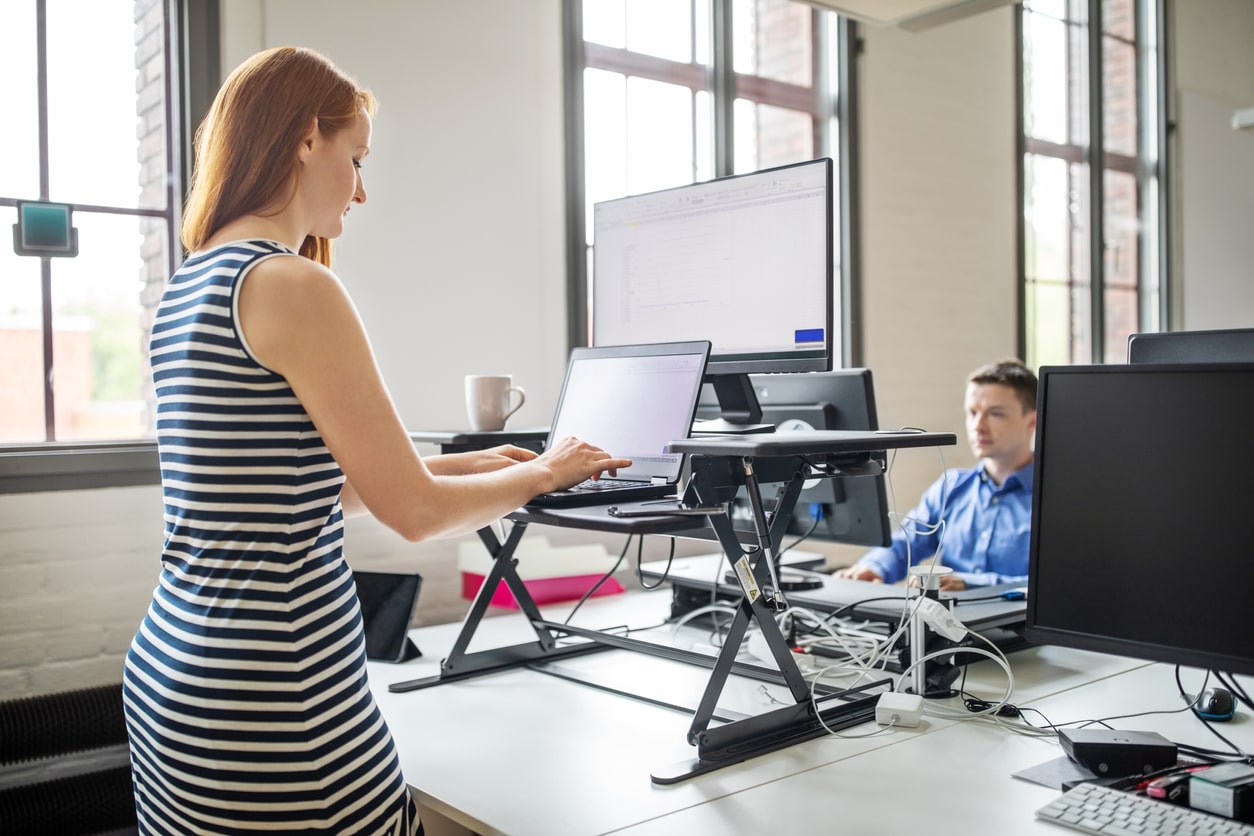
Startlingly, The Washington Post reported in 2019 that American adults spend nearly 6.5 hours sitting down each day. This number represented a one-hour increase from the average that was reported 13 years ago in 2007. Computer use at home was cited as one of the main reasons for this dramatic increase.
As much as you may enjoy your spacious work desk and comfortable plush chair, sitting for prolonged periods can take its toll on your physical and mental health. Do you ever find yourself longing to stretch your legs while on the job or even at home? Sure, you can stretch your legs during short breaks. However, a stroll to the water cooler or a quick lap outside is often not enough to relieve our bodies from the monotony of sitting.
Luckily, there are a couple of genius inventions you can purchase to give you a break from sitting during the day: desk converters and full standing desks.
Deciding to switch from a traditional desk to one that allows you to stand for portions of the day may be a no-brainer. Healthline reports that standing for short periods during the workday can offer workers the following health benefits:
- Reduced risk of weight gain and obesity
- Lower blood sugar levels
- Diminished back pain
- Reduced risk of heart disease
- Heightened mood and energy levels
Even if you have decided to switch to a desk that promotes standing, you may be having trouble deciding on which type is right for you. Below, we’ll cover everything you need to know about desk converters versus full standing desks. Once you’ve read through this guide, you can use the information you’ve learned to make an educated purchase.

Picture Credits: Ergonofis
What Are Standing Desks?
Standing desks are pieces of furniture that allow you to stand up rather than sit down while you work. With one, you can easily transfer from a sitting in your chair to standing, and vice versa.
Pros
Check out some of the benefits that a standing desk offers:
- More desktop space: A full standing desk grants you access to your entire workspace when you stand up. You will not have to bend down to reach writing instruments or important documents. Your entire workspace follows you as you stand and sit rather than just the monitor and keyboard components.
- Electric controls and keypad: Hate the idea of needing to manually adjust your work surface every time you want to stand up? When you purchase a full standing desk, this task won’t even be a concern! You can program preset heights so your desk will automatically adjust to both your sitting and standing postures. You’ll never have to waste valuable work time fiddling with your work surface.
- More options available: Because full standing workstations tend to be pricier, you’ll likely be able to customize yours to fit your needs. You can get one in virtually any shape or size you want and find a variety of different materials to fit your budget and aesthetic preferences.
- Design: Although converters can be beneficial, they tend to appear clunky and stick out like sore thumbs. Full standing work surfaces blend right into any office. They offer clean, flat working surfaces that are more aesthetically pleasing overall.
- Lift Capacity: Standing desks tend to be a bit more durable than their converting counterparts. Because of this durability, they tend to come with a higher lift capacity. A higher lift capacity is incredibly beneficial if you have multiple monitors or a clunkier computer system. You won’t have to worry about your work surface collapsing as it’s being raised.
- Can convert it to a walking desk: Depending on the model you get, you may eventually be able to convert your full standing desk into a walking desk. Standing work surfaces are designed to be empty underneath and free of invasive legs and other components. If you find yourself wanting to work a little more exercise into your day, you can slip an under-desk treadmill or elliptical machine under your workspace. This versatility allows you to change up how you can avoid sitting every day.
- Better ergonomics: A full standing desk offers better ergonomics. Most models can bring your keyboard to any height between 27 inches and 42 inches. Your monitor can similarly be adjusted to a wide range of heights. These different height ranges are perfect for tall and short individuals, and they allow for a customized user experience. Anyone can achieve perfect sitting and standing posture with this ideal height range in place.
Cons
Even with all of the pros of standing desks, there are a few drawbacks to consider:
- Assembly: In most cases, complete standing workstations do not come preassembled. They will require some special tools and handiwork to assemble, and the process can take up to an hour or longer, depending on how comfortable you are with DIY projects. If you want to add accessories to your new desk, you can tack on another hour to your setup time. Getting all of your wires set up and out of your working area will also take some additional time. While assembling your own full standing desk is manageable, be prepared to set aside some of your workday to complete the process.
- Disposal: These products are not as portable as converters. They can be difficult to fit into a new office or transfer between different buildings. Plus, if you ever want to get rid of yours and buy a new version, you may find it arduous to dispose of your old full standing desk.
- Cost: A barebones full standing workstation typically costs around $700. The price only goes up from there, depending on the brand you choose and what features you want to be incorporated. When you start shopping for a full standing workstation, know that you will be facing a hefty price tag for a quality product.
- Travel speed: Because most standing desks are electric, they may take a while to convert into the position you want them to. On average, they move up and down at about an average of 1-1.5 inches per second. It can take up to 15 seconds for a full standing product to reach the height you want it to. While this isn’t an issue for most users, you should keep a full standing desk’s slow travel speed in mind. It may become disruptive, especially if you plan on changing between sitting and standing frequently. On the other hand, most converters are manual and only take a second or two to adjust to the proper height.
Most of these cons shouldn’t make you shy away from buying a full standing desk. However, if one or more will become issues, you can look into getting a converter instead.
What to Look for in a Standing Desk
Because full standing desks can be on the pricier end, you need to make sure you buy a high-quality product. Here are a few things to look for when browsing all of the full standing desks on the market:
- Warranty: A full standing desk is a big investment, so you need to make sure you can get your money back if anything goes on. Learn about a product’s warranty before purchasing it. Does the company offer a warranty on the standing desk as a whole, or are the motors, control panels, legs, and other components covered separately?
- Assembly instructions: Some full standing desks will come completely disassembled. Be sure you’re up for some DIY work before you purchase one of these. You’ll also want to ensure that it comes with manuals, diagrams, and any specialized tools that you’ll need to properly put it together. Some products come with pieces that are partially assembled, which will require less work overall on your part.
- Ideal measurements: Don’t rush into getting a standing desk without measuring the space you have available first. This is especially important if you work in a cramped building with minimal space. You don’t want to be stuck with a clunky product that you can’t fit into your office.
- Premium features: Economical full standing desks will come with just the essentials you need to take a break from sitting during your workday. However, if you have the budget, you may want to invest in some premium features for your convenience. Cable management systems can keep wires untangled easier. Locking casters for the wheels make your desk more mobile. These features, while beneficial to some users, can increase the cost of your full standing desk and its assembly time. Think about if you truly need features like these before you invest in them. Don’t go out of your way to get anything that you’ll never use or won’t benefit from.
- Minimal motor noise: Most electric standing desks will operate on some sort of motor. Read online reviews of the ones you’re interested in to make sure their motors don’t produce loud noises that can disrupt your co-workers.

What Are Desk Converters?
A desk converter is smaller than a full standing desk. It is a sit-to-stand product that rests on top of your existing workstation. Depending on what kind you get, your desk converter may operate electronically or mechanically. Mechanical ones are adjusted using a gas spring mechanism, while electronic ones can be adjusted with a push of a button.
Pros
Standing desk converters are often seen as the more convenient option when it comes to sit-to-stand products. Check out some of the benefits that these products offer:
- They are cheaper: Desk converters tend to be a lot cheaper than standing desks. If you aren’t looking to spend a fortune but still want to take breaks from sitting, a desk converter may be the way to go. They usually range between $200-$800, so you can save hundreds of dollars when you purchase a converter over a full standing desk.
- The setup is minimal: Full standing desks can take hours of reading through manuals and studying diagrams to successfully put together. Converters require minimal setup, and some even come ready-to-use right out of the box.
- They come with multi-level designs: Converters are built with multi-level designs. They offer several adjustable levels for different equipment. Your monitor can rest on one level and your keyboard and mouse on another.
- You can keep your old desk: Rearranging an office space and incorporating a new desk can take some time that you don’t have. Instead of giving your entire workspace a makeover, you can set up a desk converter right on top of your current desk. You can keep your beloved desk without having to transfer papers and other items from its drawers. Reap the benefits of standing at work without having to completely uproot your current work area.
- They are portable: You can easily move a converter from room to room, allowing different employees to use them throughout the day. Though they are somewhat clunky, it’s possible to even move them between different buildings. This benefit of a converter can also be useful at home, as you can transfer it between a work and a gaming station.
Cons
Despite being an economical choice, desk converters have a few drawbacks you should be aware of:
- Most of them are manual: Quality electric desk converters are few and far between. Most likely, you’ll have to manually adjust yours to your desired height every time you want to stand up. However, if you have a larger budget, you may be able to find an electric desk converter.
- You may have limited surface area: Because it sits directly on top of your traditional desk, a converter will naturally take up some of your workspace. Additionally, a converter’s surface area is not as large as that of a full standing desk. Most converters are constructed to hold just your computer monitors on the main surface. Most of these products will also have an adjustable tray that can hold your keyboard and mouse. This shouldn’t be an issue if you mainly do computer work and don’t need to write things down often. However, if you’re standing and need to write something down, you will have to bend down a little bit to reach the pen and paper resting on your traditional desk.
- It may be difficult to manage your computer’s wires: Oftentimes, converters do not have wire management systems built-in. Without these in place, it can be difficult to keep all of your cables organized. The wires will move as you adjust the converter up and down. If you aren’t careful, you may accidentally tangle or unplug wires at inconvenient times. When you use a converter, you will need to carefully adjust it each time so that your computer’s wires are easy to manage.
- They may look out of place in an office setting: One of the most common complaints that users have about converters is that they can look tacky. Having a bulky frame on top of your desk may take away from the uniformity of your office space. However, this is a small sacrifice to make for the portability and convenience that a converter offers. There are plenty of converters featuring sleek designs that can even add a sense of professionalism and elegance to your office space.
These cons don’t necessarily have to be drawbacks. Rather, they are simply factors you should take into account before purchasing a converter.
What to Look for in a Desk Converter
Even though desk converters are simpler than full standing desks, they are all different in their own ways. Before you buy one, think about these important factors:
- Assembly: How hands-off do you want the assembly process to be? Pretty much all converters are easier to assemble than full standing desks. However, some will come ready to use right out of the box, while others may require you to use a few tools. Before you order one that requires some assembly, make sure you have the tools and drive to put it together.
- Special features: Some converters come with special features like a spot to hold your mobile phone. Think about all of the tasks you complete throughout your workday to determine what special features you could benefit from.
- Design: Determine how important the aesthetics of your converter are to you. You can get one that features a wood grain or certain color to match the rest of your office decor. If you plan on moving it a lot between different rooms, consider getting one with a simple design that complements a variety of aesthetics.
- Weight capacity: Pay special attention to a converter’s weight capacity. It’s no secret that converters are generally less stable than full standing work surfaces. Make sure that the converter you purchase can handle the weight of your monitors. Most converters should be able to support one monitor with no issues. However, if you plan on using two or three monitors, check to ensure that your converter can support their weight.
- Height: Most converters will have an adjustable height mechanism. Consider the height range that the one you want to buy offers. It may not have enough extension for someone very tall. Or, it may come with predetermined heights that you can’t adjust. Also, consider the height at which the keyboard tray sits. It should be adjustable as well so that you can use your keyboard and view the monitor ergonomically.
Every converter has two main components: a tray for the keyboard and a platform that holds the monitor. Consider which kind of base you want for your fixed riser:
- X-Shape: When you look at a converter with an X-shape based head-on, it looks like a smaller version of an ironing board. This model may take additional time to raise and lower, and you’ll need to treat it more gently when it’s raised higher.
- Double X-Shape: As the name implies, this version has two X-shaped bases. The additional support allows you to raise and lower the converter more quickly.
- Z-Shape: The solo arm of the Z-shape model moves in an arching pattern. It lengthens up-and-down when it’s raised and retracts when it’s lowered.
- Double Z-Shape: This is the most popular type of converter. It has two steel arms that are attached to the undersides of a platform. The platform moves toward you every time you raise it and moves away from you when you lower it, which is the opposite of what the Z-shape model does. This is the ideal model if you already have a large work surface, as it won’t interfere when you are reading papers or taking notes.
Think about which model will benefit you to most before settling on a converter to purchase.
Desk Converters versus Full Standing Desk – Which is Best?
When it comes to the topic of desk converters versus full standing desks, there are no right answers. Every individual has unique needs when it comes to their work and personal lives.
Maybe you are apprehensive about making the switch from sitting to standing at work. If this is the case, you may want to start with a converter. This product is cheaper and easier to set up, so you can more conveniently test out the concept of standing at your desk. If you have the budget, want a more durable product, and are prepared for the assembly process, a full standing desk may be right for you.
Change the Way You Work
Understanding the differences between desk converters versus full standing desks is important to create a comfortable work environment for yourself. While both of these desks are different, both will boost your productivity and mood. You’ll receive several physical health benefits that you would never get from remaining seated all day.
If you are interested in changing the way you work, consider getting either of these life-changing products today.

![The Best Standing Desks [2023 Buying guide]](https://www.zestdesk.com/wp-content/uploads/2020/04/ergonofis_standing_desk_15.jpg)